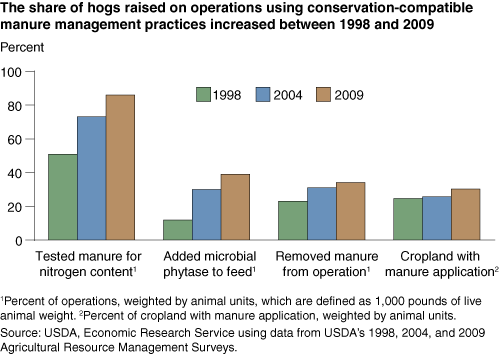Use of Conservation-Compatible Manure Management Practices Increases on U.S. Hog Farms
- by Nigel Key
- 12/1/2011
U.S. hog producers altered their manure management decisions between 1998 and 2009, suggesting an increased focus on applying nutrients at agronomic rates--that is, at levels that do not exceed what can be absorbed by crops. Over this period, hog producers applied manure to a larger share of their cropland, were more likely to remove manure from their operations, increased nutrient testing of manure, expanded their use of feed additives that reduce phosphorus in hog manure, and were more likely to have a comprehensive nutrient management plan (CNMP). Many of these shifts in manure management decisions were the result of changes in the location and size of hog operations, increasing fertilizer prices, a greater number and stricter enforcement of regulations, and more remunerative cost-share programs.
Between 1998 and 2009, hog production in the U.S. shifted to larger operations. The number of hog operations fell by about 60 percent during the period, and average inventory grew from about 2,590 to 7,930 head. With the shift to larger operations, an increasing share of production now falls under the purview of regulations governing the application of manure nutrients to cropland. Larger farms with less cropland available per head for spreading manure are more likely than other farms to remove manure from the operation, to apply manure to crops with a high rate of nutrient uptake (such as Bermuda grass), to add microbial phytase to feed, to test soil for nutrients, and to follow a CNMP.
The decline in the intensity of manure applications on land by the largest operations, and increased use of CNMPs, may be a response to an increasing number of Federal and State policies designed to reduce the over-application of manure nutrients. In 2009, 55 percent of hog farms, representing 82 percent of total animal units (defined as 1,000 pounds of live animal weight) in the U.S., followed a nutrient management plan, compared with 30 percent in 2004. The share of farms receiving USDA payments to help defray the costs of meeting regulations also increased substantially over this period (see the Resources and Environment chart on the Research Areas Chart page in this issue.)
This article is drawn from:
- Key, N., McBride, W.D., Ribaudo, M. & Sneeringer, S. (2011). Trends and Developments in Hog Manure Management: 1998-2009. U.S. Department of Agriculture, Economic Research Service. EIB-81.


